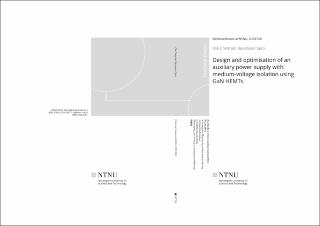| dc.description.abstract | This PhD thesis shows that compact and efficient converter systems can be obtained by leveraging the inherent characteristics of GaN HEMT devices. In the targeted application of an auxiliary power supply with medium-voltage isolation, the design, optimisation and experimental validation of the auxiliary power supply demonstrate that the high frequency characteristics of GaN HEMTs allow for high-efficiency even at multi megahertz frequencies. The high operating frequency enables the use of coreless planar transformers with solid insulation that is sandwiched with PCB windings, where the insulation thickness is significantly increased while upholding the converter efficiency compared to the literature. Additionally, the design methodology of the transformer is modified to include the coupling capacitance of the transformer. This capacitance constitutes a highfrequency noise path and must be minimised in order to avoid affecting the operation of the main converter.
In this PhD work, an auxiliary power supply is designed based on a resonant topology operating at 6.78 MHz. The design methodology results in a compact rectifier with inherent output voltage regulation. Simulation-based design methodologies for both the converter topology and the isolation transformer are presented, followed by experimental validation. For the converter, the optimisation process uses a genetic algorithm. Designs are evaluated through 2D finite element analysis and SPICE simulations. Four prototypes were made from the identified Pareto front. These prototypes were able to transfer from 11 to 16W with a measured peak efficiency of 81% and the output voltage regulation is experimentally validated. However, there is a discrepancy in simulated and measured inverter losses despite the effort to model the additional loss factors of GaN HEMTs, namely dynamic on-state resistance and Coss-losses. Thus, these losses represent a hindrance for improving the efficiency of converters operating at high frequency. Consequently, virtual prototyping, which is more time- and material-efficient than design by prototyping, also becomes more challenging.
Finally, the thesis presents a design methodology for a compact, printed, highfrequency isolation transformer with medium-voltage isolation that can be used in the previously presented resonant converter. The methodology takes the coupling capacitance of the transformer into account. Additionally, possible field-grading methods are investigated with permittivity field-grading showing the most promise for the application. Experimental breakdown tests are performed according to IEC standards. Using printed windings allows for producing windings with higher accuracy and higher precision. Characterisation of the transformers shows low variation in transformer parameters from the simulated values. | en_US |
